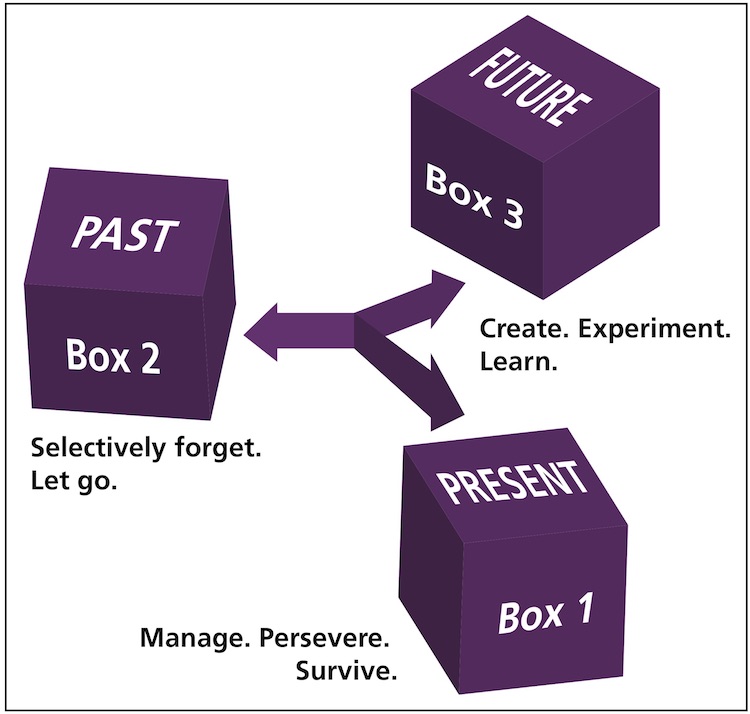The Three-Box Solution for Innovation
By Karen Thickstun, NCTM
American Music Teacher, December/January 2020/2021
Download PDF
Unprecedented. Fluid. Evolving. Uncertain. Pivot. We have heard these words many times during the past nine months and may be feeling paralyzed or overwhelmed—unable to even consider innovating our studio or association.

Vijay Govindarajan, an expert on strategy and innovation, suggests a framework represented by three boxes inspired by the three main gods of the Hindu faith: Vishnu, the god of preservation; Shiva, the god of destruction; and Brahma, the god of creation (2016, 14). The three boxes are:
1. Manage the Present
2. Selectively Forget the Past
3. Create the Future
Box 1, the Present, is our comfort zone where we maintain activities and events that are well-known and understood by our students and members, having been developed and fine-tuned over time. To optimize our present business, we analyze what works, develop a plan and stick with it. We keep the core business running and provide stability.
Box 2, the Past, requires us to take a hard look at what got us to the present. Are our practices and attitudes so entrenched that we cannot (or do not try to) see where we are unwelcoming or indifferent to new ideas? Recognizing when we are resting on past practices that are no longer relevant is a first step. Letting go of past habits or attitudes frees up space and resources to make room for new ideas. This is tough work. Govindarajan further clarifies that we should keep the roots (core values that are timeless) but cut the chains (practices or structures that are no longer useful) (2016, 24).
Box 3, the Future, is where we experiment, learn and grow. To mitigate risk, we test out assumptions and learn from failures. Over time, we decide to exit, or we develop confidence in a potential new direction. Govindarajan says "Don't focus on what the future will impose on you; focus on what you can do" (Blanding 2016). Through small experiments with new concepts or markets, you focus on what is under your control rather than getting overwhelmed by outside forces. The future is not a point far off in the distance. It is today. You build it day-by-day through small steps.
Govindarajan advocates that innovation is the result of daily attention to all boxes. When managed and balanced together, an organization is positioned to weather crises and take advantage of opportunities. He describes the process as endlessly cyclical, requiring us to think and act simultaneously in all three time frames. Through continuous learning, we cycle through preserving the present, forgetting the past and innovating for the future. "Learning is intrinsically a humbling activity; to learn is to admit you don't know everything. Almost every aspect of the Three-Box Solution framework is intended to increase opportunities to listen and learn" (2016, 31).
The Three-Box Solution reminds me of my landscaping efforts. Every week, I am operating in the present (pulling weeds), forgetting the past (pruning or removing plants that have overgrown their space) and creating the future (experimenting with transplants in new spaces).
Implications for Our Profession
How might the Three-Box Solution help a studio or local/state association seek innovation? Is it possible to keep daily operations running while simultaneously planning for the future and selectively forgetting the past? This is especially challenging during trying times when we tend to live in the present and set all else aside.
The future starts today—not in a year after a strategic planning meeting. Begin by exploring tiny innovations as possible directions for future ventures. Identify past assumptions/barriers and let them go.
The pandemic forced us into certain new ventures, but now we have the opportunity to move forward with some (or maybe all) of those ventures, while leaving some of our old practices behind. I predict that many of us will view make-up lesson options quite differently in the future, given the comfort that we have gained with online teaching formats. Multi-event festivals/competitions may find that some elements, such as theory testing, are more efficient online, while other elements, such as repertoire, are best served by returning to an in-person experience.
Or is it precisely because of the COVID disruption that online competitions have become more accessible and thus led to higher participation? MTNA national competition enrollment hit an all-time high this fall (with all state, division and national rounds to be held virtually). Virtual state and national conferences have reached new audiences. Online lessons have allowed studios to embrace students wherever they live.
As a profession, we are well into the experiment stage of box 3. It is time to listen, learn and grow. And let go of past chains. We live in exciting times!
References
Blanding, Michael. 2016. "A Three-Box Solution to Managing Innovation." https://hbswk.hbs.edu/item/a-three-box-solution-to-managing-innovation.
Govindarajan, Vijay. 2016. The Three-Box Solution: A Strategy for Leading Innovation, Boston, MA: Harvard Business School Publishing.

Karen Thickstun, NCTM, teaches piano pedagogy at Butler University and directs the Butler Community Arts School. She holds degrees in music, economics and business. Thickstun is MTNA president-elect.